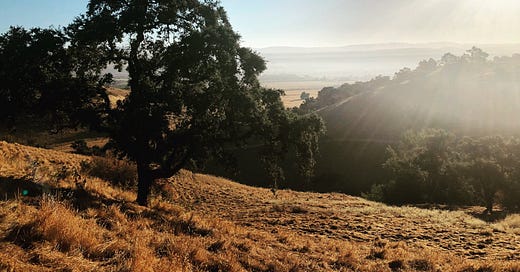Last month, my son led a short lesson for our nature group. As we sat in the shade of a big valley oak tree, he asked us to consider how the ecology of this specific valley would change if it weren’t for this tree. I knew what his lesson would be about, but this pointed question caused me to pause. I’ve been thinking about it ever since.
My first thoughts went to the Western Kingbird. I initially met the Western Kingbird, about five years ago, sitting under this very tree. As I chatted with some friends while our kids played tag, I noticed a flash of yellow in the branches, and heard a bird call that was new to me. I have wonderful memories of one of the moms and me craning our necks backward until they were perpendicular to our bodies. We snagged binoculars from our children and stared into the tree for much of that morning, trying to get a better look at the industrious duo of kingbirds building their nest. I remember the excitement of identifying a new-to-me bird. To this day I look for that fantastic flash of golden yellow when the morning sun glints off the kingbird’s feathers in this same spot every spring.
Within the shade of the oak tree, there are dangerous clusters of ground squirrel holes. I say dangerous because last week I fell after getting my foot caught in one. They pose quite an obstacle to the children’s games of tag. But the squirrels provide us with regular entertainment. And the summer provides a host of squirrelly antics as the babies make their debut. I’m always surprised by the courage of the youth that sprint across our paths in a valiant effort to reach their hideout, or collect some acorns they don’t want us to steal, as they watch us closely with curious eyes. But the holes are not only treacherous to our ankles. Besides hiding squirrels, they can be home to snakes. Most snakes here aren’t dangerous, but my son seems to particularly enjoy the thrill of finding rattlesnakes. So we have a strict no-hands-in-squirrel-holes policy. Though having a child who is mesmerized by all forms of animal life, even the less desirable kind, has broadened my sense of beauty even here. And I, too, appreciate catching a glimpse of the serpents every now and then. From afar.
There is another creature that enjoys the squirrel holes. And recently, whether due to drought or shrinking territories, we’ve been able to observe this otherwise elusive character. Usually coyotes prefer to give humans a wide berth. However, last year we began seeing a pair of coyotes playing and hunting in the fields around our oak tree. We watched as one coyote would trot across the field leisurely, and then pounce and dig as it, usually, missed the ground squirrel it was hunting. Occasionally we’d see the pair of coyotes meet and, as I imagined it, discuss their strategy for clearing the entire field of the squirrel population. I also imagined that as the afternoon wore on, they found the shade of an oak and laid down together to allow the heat of the day to pass. I often wonder if one of these oaks has a den amongst its roots where they raise a family. It’s a privilege to have them for neighbors.
I’m reminded, as I watch the end of a riveting game of tag, that the coyote is not the only one to raise its family beneath the shade of the oak tree. How many mornings have I sat under this canopy, alongside my friends, watching our children scamper about from squirrel hole to squirrel hole? It is not just the squirrels who are curious. It is not only the coyote who seeks the shade as it observes the landscape. It is not only the kingbird that makes its home here, calling cheerfully to its young in the nest. Have we not done the same? Returning week after week, we too raise our little ones beneath the shade of this very oak, nurturing a relationship with the flora and fauna that graciously allow us in. Where would we be without this oak tree?
Sarah Jonnalagadda 2023



